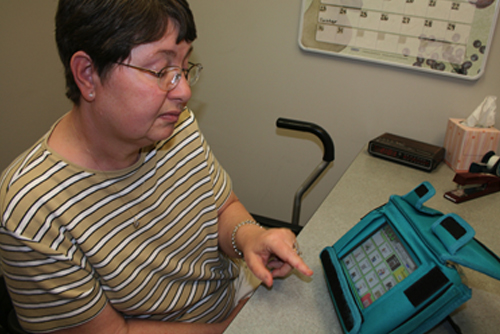PEARL—Playing charades used to be a never-ending pastime for Gayle and Ken Heckman.
She would gesture, and he would guess what she was trying to say. It’s how the Pearl couple communicated after a 1993 stroke left Gayle struggling to speak or write.
Now the Heckmans are happy to report that there’s a new game in town. Today, Gayle just taps a touch screen to tell Ken everything from “I love you” to “the plants need watering.”
The conversation comes courtesy of the Dynavox Minimo, an augmentative communication device that allows Gayle to give voice to her thoughts.
While such devices have been around for years, the Heckmans weren’t impressed with the oversized versions available in the 90s. They were too cumbersome for Gayle, who has a paralyzed right arm and wears a brace on her right leg.
But the recent arrival of user-friendly models like the 3.5–pound Minimo convinced the couple to give the technology another try. And Ken said he knew exactly where to turn for a tutorial. “I contacted the company and requested we come to Methodist Rehabilitation Center,” he said. “We’ve had more positive results at Methodist than anywhere else.”
A 41-year-old mother of four at the time of her stroke, Gayle came to Methodist Rehab in Jackson to take advantage of the state’s only stroke-specific rehabilitation program. There she found a staff well-versed in the diagnosis and treatment of aphasia, a puzzling neurological disorder that strikes 25 to 40 percent of stroke survivors and profoundly affects their ability to comprehend and express language.
Kristi Crisler, a speech-language pathologist at Methodist Rehab’s outpatient neurological facility in Flowood, said Gayle was found to have severe difficulties communicating verbally. For instance, she was limited to a handful of words such as “hey” and “no.”
Crisler has been programming the Minimo to meet Gayle’s conversational needs, a process that involves creating screen “buttons” to represent chosen words and phrases. It’s a challenging task because Gayle relies more on visual cues than written words to access the language.
“You have to be creative with icons,” Crisler said. “For instance, O’Charley’s Restaurant is famous for their rolls, so we put a picture of a roll on that button. For Cracker Barrel, we put a picture of a cracker.”
It’s no mystery why so many restaurants made Gayle’s list of must-have icons. She and Ken have never let her disability cramp their outgoing lifestyle. They’ve always shopped together, traveled together and eaten out a lot. The Minimo just makes it easier for Gayle to convey favored destinations.
“Lots of times she would want to tell me something specific and she couldn’t do it,” Ken said. “Sometimes we would have to get in the car and she would just gesture which way to go.”
Conversations about people also could be perplexing. But now Gayle can bring up the names of family and friends on her device, and it’s also possible to include their pictures.
Crisler said such customization is one of the strength’s of today’s augmentative communication devices. For example, most let users select from a variety of computer generated voices – male, female, Southern accented, etc. Recorded voices can be added, too, and several of Gayle’s phrases feature Crisler’s voice. Some devices also have onscreen keyboards to allow users to type words or phrases that aren’t pre-programmed.
Speech-language pathologists consider a person’s cognitive, vision and motor skills before determining which device features are best for each individual’s needs. “Gayle’s device can go up to 20 buttons on the main touch screen,” Crisler said. “But because she has tremors in her hands, we decided larger buttons would be easier to access.”
Crisler said Gayle recently began taking her device home, and the added practice and repetition have improved her ability to locate buttons independently. “This enables her to communicate wants and needs more effectively with family and friends,” Crisler said.
While Gayle’s smile says much about her satisfaction with the new device, she’s glad to have another way to express her feelings. Now she can push a button marked with a smiling face to say: “I am happy.”
The augmentative communication program at Methodist Outpatient Neurological Rehabilitation is designed to meet the varying needs of people with communication difficulties. The program’s speech-language pathologists have undergone specialized training on numerous devices to effectively determine the most appropriate augmentative communication device for each individual. For more information on the program, call 601-936-8889.


